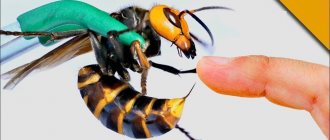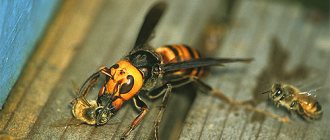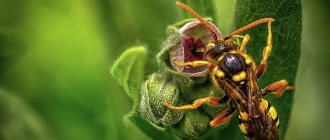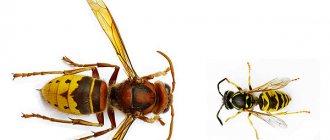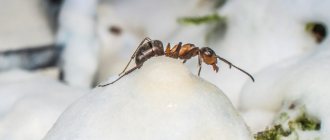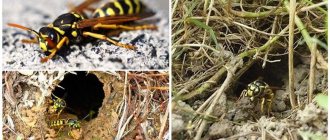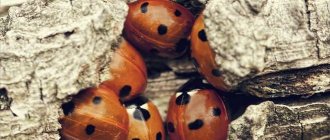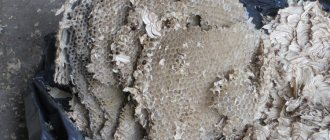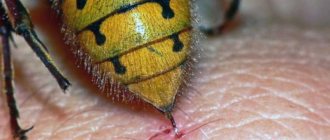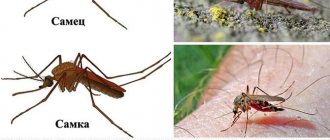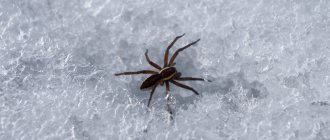By the end of August, wasps become extremely annoying, they climb everywhere, land on sweets, and fly into houses. But with the onset of autumn, there are fewer and fewer insects, and then they completely disappear from sight and appear only in late spring, when warm weather sets in.
Those who constantly encounter striped aggressors in their summer cottages and regularly fight them are interested in the questions of whether wasps die in winter or sleep, and what needs to be done to prevent them from returning when the weather warms up.
Do wasps die in winter?
In autumn, when the air temperature steadily drops, wasps gradually begin to disappear. They no longer circle over sweet fruits hanging on trees or fly into houses. The thing is that most of the adult individuals die with the onset of cold weather, and the remaining ones hide in secluded corners until spring.
To understand why this happens, we need to take a closer look at the process of wasp reproduction. All summer the queen reproduces sterile worker wasps. And only at the end of summer do males and females capable of fertilization begin to appear. They actively mate, after which the males, whose main task is completed, die.
Dead wasps
The same fate awaits worker wasps, who live for about 1.5–2 months and fall asleep when the temperature drops below the critical mark of +10⁰С, and die with the arrival of real cold weather. The queen leaves the nest in the fall, like other insects, and also dies with the onset of cold weather.
As a result, only fertilized females remain for the winter. They hide in secluded places, fall into suspended animation and sleep until spring.
What do they eat in summer
The diet and feeding habits of larvae and adults differ significantly. Thinking about what wasps eat, you might think that they are omnivores, but this is a mistaken opinion. There are quite a lot of things that wasps eat and will never touch. Moreover, they are quite picky when it comes to nutrition.
The most constant food for insects is fruit and berry juice, which ripens during the period of their activity. Such nutrition is the main source of energy. In addition, wasps love the insides of berries and are able to leave behind only the skin. This applies to plums, raspberries, strawberries, blackberries and grapes.
Representatives’ favorite products are also:
- Sugar;
- Honey products;
- Fruit varieties of jam;
- Sweet syrups.
In turn, the larvae feed exclusively on protein tissues, that is, other insects. Suitable for feeding and development of future offspring:
- Slug;
- Butterfly;
- Spider;
- Caterpillar;
- Cockroach;
- Bedbugs and other insects.
Important! If there are hives with bee families nearby, there is a danger of the striped workers being destroyed by predators.
Where do they winter?
The most common version is that after the wasps leave the nest with the onset of cold weather, they look for a place where they can overwinter. But there is another one - insects are looking for a place to winter not in the fall, but starting from the end of summer. In any case, the shelter in which the wasp will spend the winter must maintain a constant temperature and be as closed as possible from wind and frost. That is why in the fall, wasps sometimes actively climb into a house, barn, or bathhouse, hiding in cracks and crevices.
Most often in nature, wasps spend the winter in places such as:
- tree bark (insects gnaw holes in it or get into existing cracks);
- in old rotten stumps;
- in rotten fallen trees;
- in a heap of fallen leaves.
Wasps moisten the walls of their winter shelter with saliva. Thanks to the enzymes it contains, the wood becomes denser and better protects the female until the weather warms up and she can fly again.
Can wasp venom be used as a treatment against cancer?
Spain really took the beneficial properties of wasp venom seriously. Just recently, a group of scientists from the Barcelona Institute of Biomedical Research published the results of experiments in which components of wasp venom were used to kill cancer cells.
The idea of using wasp venom in this way is well understood: if its components successfully destroy the walls of ordinary cells, as well as blood cells, then they can also destroy cancer cells. The task was only to force the toxins to selectively act on cells - to destroy cancerous ones, but not to touch healthy ones.
In test tube experiments, scientists were able to “glue” the molecules of the individual components of wasp venom with a special protein that could only connect to the surface of the cancer cell. As a result, such a tandem safely passed by all the healthy cells in the culture and immediately stuck to the cancer cell that came across its path. This was followed by the destruction of the cancer cell membrane and its death.
All these encouraging results are just the beginning of a long journey. The next step is to test a drug made from bee toxin and a special transport protein on mice.
Of course, pure wasp venom cannot be considered a useful cure for cancer. And it would be even more stupid to use wasp stings for this in everyday life: the poison will equally affect both healthy and diseased tissues.
Wintering process and diet
If anyone is interested in what wasps eat in winter, then essentially nothing. Since they fall into suspended animation, all processes in the body, including metabolic processes, slow down significantly. The wasp not only doesn’t eat, it doesn’t even move and practically doesn’t breathe. However, nature has arranged it so that even in hibernation, the insect’s body receives nutrients. The female has been accumulating them since the end of summer, when she begins to actively eat, absorbing more food than usual. So, when flying away in search of winter shelter, the wasp already has a decent supply of nutrients, which helps her survive the cold winter.
Main distinguishing feature
The life of a wasp depends on whether it is a social or solitary individual. Already from the name it becomes clear that the former live in families, and the latter – separately. This division exists in all numerous insect species. Each single individual has the opportunity to reproduce. In the family, only the uterus continues the family line.
Solitary wasps prefer not to live in large groups. They mate and then lead a solitary life. Paper single females build their nest. In each cell, in addition to the laid egg, the female places a supply of food for the impoverished larva. These are small insects and spiders paralyzed by poison. Having filled the cell, the female seals it.
The larva eats the supplies prepared by the caring mother and develops inside the cell. When it reaches maturity, it gets out of the nest on its own. Young insects fly away in search of a place to build their own “home”.
Dangers of wintering
Not all females survive the winter and go in the spring to build a wasp nest for a new family. After the wasps fall asleep, various dangers can await them. So, what threatens sleeping insects:
- they are found and eaten by birds or animals;
- during a thaw, the snow and ice covering the secluded places where insects are hidden melt, the wasps freeze (or are blown outside by the wind, where they also die from the cold);
- Also, during a thaw, insects may find themselves under water and die.
The easiest way for wasps to survive a snowy winter is when their temporary shelter receives additional protection in the form of snow.
Where and how do hornets winter?
Hornets are one of the largest wasps existing on the planet. In terms of their wintering method, they differ little from ordinary wasps. Insects also leave the nest in the fall and find a suitable place in which they hide until the weather warms up. Cracks in wooden buildings, hollows, and voids in the bark of trees are suitable as shelter. The hornet can even survive quite severe frost. This is because the liquid in his body is identical to glycerin, so it does not turn into ice.
Hornet
As in the case of wasps, only fertilized females hibernate in hornets, and with the arrival of spring they begin to create a new family.
Aggressive insect
The peculiarity of the structure of the ridge allows the head to move very well. The mouthparts of an insect are of the gnawing type. It is designed to grind food and wood fibers used in the construction of honeycombs. Stripes have a serrated sting, which does not have a knot at the end, but the serrations are smaller than those of a bee.
Only females have a sting. After all, in essence, it is an ovipositor, through which, if danger arises, the “minke whale” can also spray poison. But wasps are quite aggressive and prefer to attack first. Females quite often use the sting for purposes other than its intended purpose.
Nature dictates that the bright yellow-black color makes the insect very noticeable and thereby warns other animals that its owner is poisonous. The minke whale stings and bites its opponent. Although the bites are less painful than the venom released by the stinger.
It should be borne in mind that minke whales attack at the slightest disturbance - this demonstrates how dangerous they are to their enemies. When biting, it does not leave a sting in the body of its “victim”, as bees do. Therefore, insects do not die after being stung. They may repeat the attack again.
It is very important to know that the venom of the striped insect has a smell. If one wasp stung and another was nearby, it will smell the poison and fly to the aid of its “relative.”
It is especially dangerous to disturb a formidable arthropod near its home. Then the whole family can attack. It’s not for nothing that there is a saying “to stir up a hornet’s nest,” which implies major troubles.
When do wasps wake up?
Wasps hibernate for quite a long time. They are not awakened by the thaw and the rays of the spring sun. In order to wake up, insects require certain environmental conditions. First of all, it is the air temperature. Wasps begin to wake up only after the thermometer rises above +10…+12⁰С. When the air warms up to +15⁰C, insects begin to live in their normal rhythm.
So the exact timing of when wasps will emerge from their winter hiding places varies depending on their region and weather conditions. But it’s not immediately possible to see wasps in the spring, because at first there are very few of them and everyone is very busy building a house for the new season.
Will wasps return to a hive under a roof in the spring?
Regardless of where wasps spend the winter, with the onset of warm weather they need a home where they will live, where a new generation will be born and grow. Singles find a suitable place and arrange their home themselves. The queen begins to build a house for the future colony. At first, the nest consists of only a few cells where the queen lays her eggs. But gradually the nest grows, and when the first generation of worker bees grows up, the construction process accelerates significantly.
There is an opinion that wasps never return to old nests, but most often build new ones in familiar and familiar territory - in the same barn, on the veranda or under the roof of the house. However, many of those who live outside the city are ready to argue with this statement, claiming that they have more than once noticed how insects return to their former homes in the spring.
Variety of species
The wasps that are familiar to most of us and have yellow and black stripes on their bodies are called paper wasps. This species name is due to the fact that the material from which insects build their homes is very similar to paper. It is made from wood fibers chewed by arthropods, which are glued together with saliva.
Other types of wasps have different colors. The size of the insect depends on its species. They range from 1.5 cm to 10 cm. What do wasps eat? The adult eats mainly liquid food - nectar, fruit juice. For their larvae, wasps get: flies and other insects. Predatory wasps themselves eat insects, and can also feed on other types of food.
The wasp catches its prey and injects its poison into it through its sting, which does not kill, but only paralyzes. Thus, the meat of the prey is kept fresh until the time of the meal.
Different types of wasps live almost everywhere. For example, ground wasps choose soil to build their “homes”. Paper wasps build their “family nest” under a tree branch or on any structure. It should be noted that wasps are very willing to settle near people. This proximity makes it much easier for them to find food. The wasp eats sweets and other foods left in a visible place in a person’s home. But also, it catches pests there such as flies, which carry various infections and thereby brings benefits. In the garden, wasps can find not only flies and ants, but also a huge number of insects that are pests. Wasps love honey very much and therefore pose a threat to bees.
The queen is the largest individual of the paper wasp family. The length of its body is approximately 20 millimeters, while the body length of a working wasp or drone is about 18 millimeters. Females have a larger abdomen than males. Insects do not differ in body color by gender. Males and females have the same yellow and black striped color.
Reproduction
The future queen builds a honeycomb, in the cells of which she lays eggs. After a few days, carnivorous larvae appear, demanding meat food. During this period, the female is actively engaged in the destruction of tree pests; they serve as food for the growing larvae. The first wasps are sterile females and will assist the queen in caring for the next generation and building the nest.
In August and September, young queens and males will appear ready to mate for reproduction. After fertilization of females, most males die. Old queens that have lost the ability to lay eggs will not survive the second winter. They will die along with the workers. Among the many species of paper wasps, there are females whose life cycle is 2-4 years. They enter a state of winter sleep several times.
Information. What do wasps eat in winter? Before the onset of cold weather, females try to accumulate more nutrients in the body. After entering diapause, they become so passive that they survive the winter due to accumulated substances.
Birth and nest construction
Wasps are not noticeable in winter and early spring, but with the onset of stable warmth, the first scouts fly out. These are future queens who, since last autumn, have been storing in their bodies the sperm of the males who fertilized them. Insects look for the first flowers to feed on nectar. The young female will have to fulfill the main function of her life - to give birth to a new family. She finds a suitable place and begins building a nest. The material is chewed tree bark, generously moistened with saliva. After drying, the substance becomes like thick paper.
Fighting wasps in the autumn-winter period
Many people prefer to carry out a set of measures during the cold season that will help in the future protect their plot and home from the appearance of wasps. Since insects leave their homes and hibernate in the fall, you can act without fear of attack.
Control of wasps in late autumn includes the following actions:
- inspection of all wooden buildings, bushes, trees, woodpiles with firewood, boards stacked on the site for the presence of wasp nests;
- destruction of all found nests;
- treating the area where the nest was located with a product with a strong strong odor, for example, kerosene or dichlorvos;
- collecting and burning plant debris and fallen leaves;
- removal of branches and rotten stumps from the site.
In addition, you can purchase insecticides and repellents that may be useful for fighting insects in the next summer season. In winter, the choice of such products is greater, and their prices are lower.
